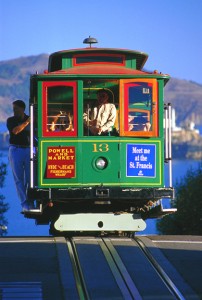
In 2007, San Francisco voters passed Proposition A and directed the SFMTA to “develop and implement strategies for substantially reducing” transportation sector carbon emissions. The 2011 CAS meets the 2007 directive by proposing six GHG mitigation strategies that build upon San Francisco and global best practices. The strategies address transportation sector policies and programs needed to meet adopted GHG reduction goals of 80 percent below 1990 levels by 2050.
The CAS is a living document that will be updated every two years as data becomes available from pilot projects and new modeling practices. Quantifying GHG reductions has been challenging due to the availability and quality of data sources. Future updates will include more detailed financial information, cost-benefit analyses, environmental assessments, and life cycle costs. For now, the research of the past two years indicates that these six strategies deserve the region’s full attention in meeting the voice of the citizens of San Francisco. The recommendations include new programs and build upon pioneering city policy already adopted. They will need to go through the feasibility and environmental analysis processes, secure funding from existing and new sources and be formally adopted. In addition to the new city policies, a combination of regional, state and federal policies are also recommended in order to realize the greatest reduction in carbon emissions.
Climate Action Strategy Framework
The 2011 CAS creates the foundation for a financially, environmentally, and socially sustainable transportation system by targeting the most effective GHG reduction strategies and identifying key collective actions, policy changes and infrastructure investments. It serves as the transportation chapter of the 2011 Communitywide Climate Action Plan being led by San Francisco Environment (SFE) that includes the built environment, energy and water consumption, water transport, waste reduction, and recycling sectors.
While vehicle energy efficiency is mostly an industry and regulatory responsibility, travel demand management and supporting infrastructure are within the purview of the SFMTA and its partners. Mitigation is only the first major step in climate action planning; adapting to inevitable changes in storm severity, drought, sea-level rise and transportation system reliability will be developed as part of future document updates. Infrastructure risk assessment and related risk reduction strategies will be recommended at that time to create a resilient transportation system.
San Francisco Surface Transportation System
The SFMTA plans, designs and manages most of the surface transportation system in San Francisco including the San Francisco Municipal Railway transit system (Muni), paratransit, the street network for automobiles, commercial vehicles, bicycles, pedestrians, taxis, as well as parking, traffic signals, signs and traffic enforcement. The SFMTA provides connections to and partners with, six regional transit providers: the Bay Area Rapid Transit District (BART-regional heavy rail), Golden Gate Transit (commuter bus and ferry), Samtrans (commuter bus), Caltrain (commuter rail), Alameda-Contra Costa (AC) Transit (commuter bus) and the Water Emergency Transportation Authority (WETA ferries) to provide regional transit to and from the city. The California Department of Transportation (Caltrans) operates the state highway system and Amtrak bus service connecting the city to the region. The Golden Gate Bridge, Highway and Transportation District and Bay Area Toll Authority operate the Golden Gate and Bay bridges, respectively. Additionally, there are a growing number of private local and regional shuttle services providing door-to-door access within San Francisco and employment centers beyond. Lastly, intercity bus services, goods and service delivery companies, vehicle rental companies, limousines, carsharing and bicycle rental operators provide transportation and goods movement services in the city.
The strategies in the CAS improve access to goods, people and information around San Francisco. The total costs associated with maintaining our hyper-mobile lifestyle will undoubtedly increase in the coming 25 years. The 2011 CAS identifies future investments and quantifies the GHG reductions needed for San Francisco’s sustainable transportation future.